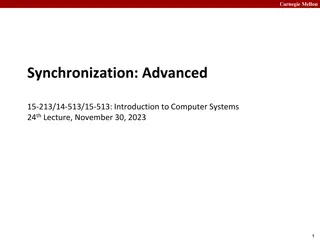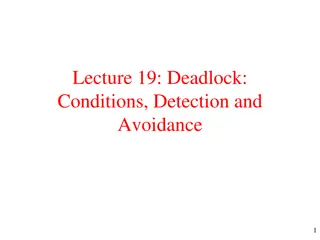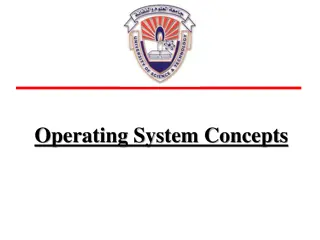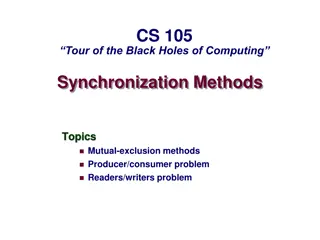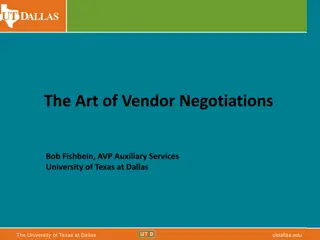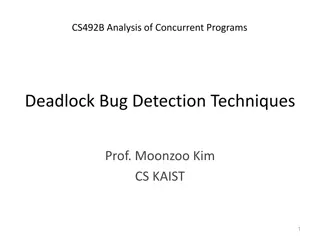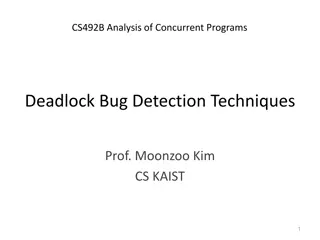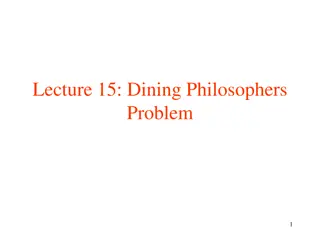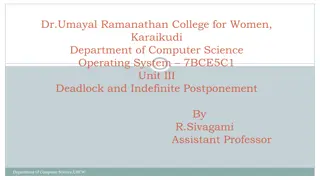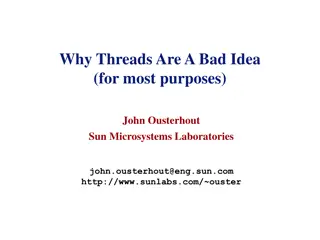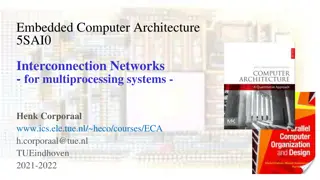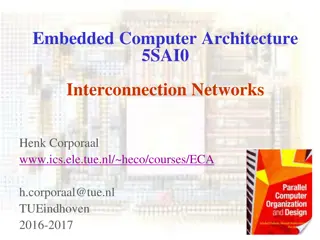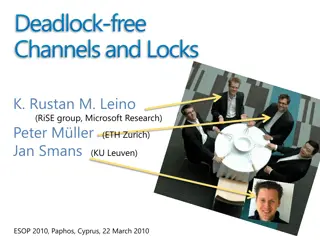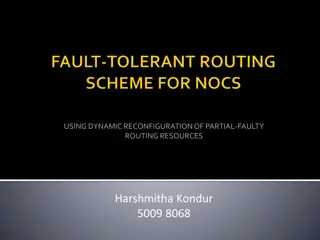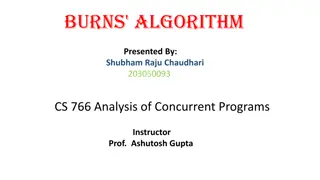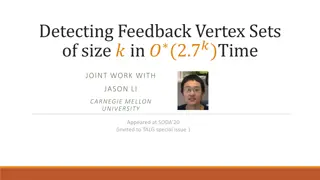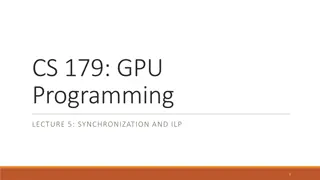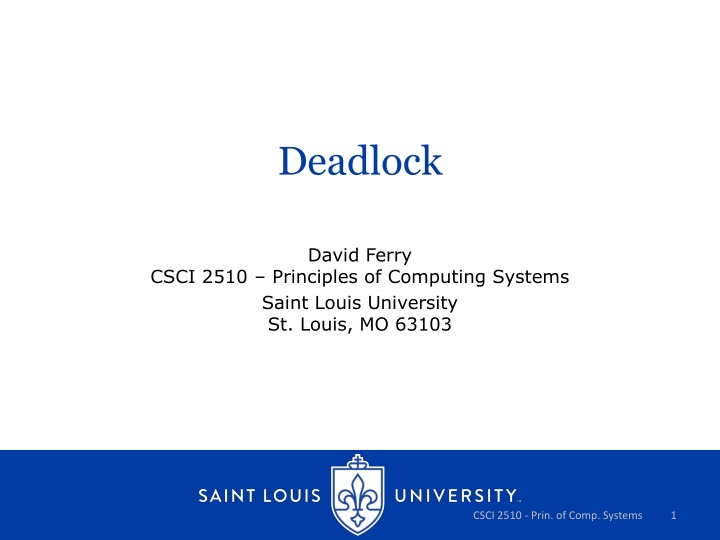
Deadlock in Computing Systems
Explore the concept of deadlock in computing systems through examples like blocking operations, classic dining philosophers, and potential hazards. Learn about scenarios where programs wait indefinitely due to resource conflicts, enhancing your understanding of system vulnerabilities and critical sections.
Download Presentation

Please find below an Image/Link to download the presentation.
The content on the website is provided AS IS for your information and personal use only. It may not be sold, licensed, or shared on other websites without obtaining consent from the author. If you encounter any issues during the download, it is possible that the publisher has removed the file from their server.
You are allowed to download the files provided on this website for personal or commercial use, subject to the condition that they are used lawfully. All files are the property of their respective owners.
The content on the website is provided AS IS for your information and personal use only. It may not be sold, licensed, or shared on other websites without obtaining consent from the author.
E N D
Presentation Transcript
Deadlock David Ferry CSCI 2510 Principles of Computing Systems Saint Louis University St. Louis, MO 63103 CSCI 2510 - Prin. of Comp. Systems 1
Blocking Operations Recall- Some operations cause a program to wait. Quiz: Which of the following operations could cause blocking? A. Locking a mutex B. Opening a file C. Reading a file D. Reading from a pipe E. Writing to a pipe CSCI 2510 - Prin. of Comp. Systems 2
Blocking Operations Recall- Some operations cause a program to wait. Quiz: Which of the following operations could cause blocking? A. Locking a mutex (already locked) B. Opening a file (disk I/O) C. Reading a file (disk I/O) D. Reading from a pipe (pipe is empty) E. Writing to a pipe (pipe is full) CSCI 2510 - Prin. of Comp. Systems 3
Deadlock A specific hazard occurs with blocking operations: Could an adversary scheduler break our code? mutex a, b; Thread 1: lock(a) lock(b) //Critical section unlock(b) unlock(a) Thread 2: lock(b) lock(a) //Critical section unlock(a) unlock(b) CSCI 2510 - Prin. of Comp. Systems 4
Deadlock A specific hazard occurs with blocking operations: Could an adversary scheduler break our code? mutex a, b; Thread 1: lock(a) lock(b) //Critical section unlock(b) unlock(a) Thread 2: lock(b) lock(a) //Critical section unlock(a) unlock(b) Infinite wait 1. 4. 2. 3. CSCI 2510 - Prin. of Comp. Systems 5
Classic Deadlock Example: Dining Philosophers A group of philosophers are sharing a delicious spaghetti meal. Six thinkers, six forks, each needs two forks to eat. Each philosopher follows the procedure: while( 1 ){ 1. Ponder mysteries for a while 2. Grab fork to their left (or wait) 3. Grab fork to their right (or wait) 4. Eat 5. Release forks } Spaghetti: Powerpoint Stock Photos CSCI 2510 - Prin. of Comp. Systems 6
Recall Lab 2 How could deadlock occur if the parent shell process waits on each child after forking instead of just the last? SLU Shell Process fork() fork() fork() STDIN STDOUT ls grep sort ls output sort output pipe pipe CSCI 2510 - Prin. of Comp. Systems 7
Recall Lab 2 How could deadlock occur if the parent shell process waits on each child after forking instead of just the last? SLU Shell Process fork() fork() fork() STDIN STDOUT ls grep sort ls output sort output pipe pipe CSCI 2510 - Prin. of Comp. Systems 8
Necessary Conditions for Deadlock Which of the following elements occurred in all three examples? Philosophers Graph cycles Processes Threads Resource exclusion Locking Mutex variables Waiting Pipes Spaghetti CSCI 2510 - Prin. of Comp. Systems 9
Necessary Conditions for Deadlock Which of the following elements occurred in all three examples? Philosophers Graph cycles Processes Threads Resource exclusion Locking Mutex variables Waiting Pipes Spaghetti Deadlock is not just a property of threads, locks, and mutexes- it is a general systems problem. CSCI 2510 - Prin. of Comp. Systems 10
Deadlock Conditions 1. Resource exclusion Processes can hold resources in a non-shareable state Hold-while-waiting Processes can hold a resource while waiting for another resource No preemption Only the process holding a resource can release it Circular wait There can exist a set of waiting processes P1 PN such that P1 waits on P2, P2 waits on P3, PN-1 waits on PN, and PN waits on P1 2. 3. 4. 1 2 6 3 5 4 E. G. Coffman. System Deadlocks. ACM Comput. Surv. 3, 2 (June 1971), 67 78.
Deadlock does not require explicit resource acquisition The shell process calls wait() on the first child process, the child process calls write() on the pipe. The pipe is full. No process ever explicitly acquires a resource. Possibility of deadlock is an inherent property of a design That said, most of the time we talk about explicit acquisition SLU Shell Process fork() fork() fork() ls STDIN STDOUT grep sort ls output sort output pipe pipe
Real-World Example: Gridlock Is this deadlock? Resource exclusion Hold-while-waiting No preemption Circular wait Attribution: Rgoogin at the English Wikipedia CSCI 2510 - Prin. of Comp. Systems 13
Which of these contain Deadlock? Rule: Cars must drive in a straight line until they re out of their box. C E A D B CSCI 2510 - Prin. of Comp. Systems 14
Can Deadlock is not Will Deadlock Deadlock may or may not occur during any specific execution Usually results from a race, so depends on timing Just like race conditions, thorough testing is not guarantee of finding deadlock Developer must reason about the system and convince themselves the system is deadlock-free E.g. Philosophers don t always deadlock Exercise: Give an execution for Dining Philosophers that doesn t deadlock CSCI 2510 - Prin. of Comp. Systems 15
Starvation Related concept, will only introduce here: Starvation Individual processes may be unlucky and unable to progress Example: Threads race and 1 never gets to lock(a) mutex a, b Thread 1 lock(a) lock(b) //process data unlock(b) unlock(a) Thread 2 lock(a) lock(b) //process data unlock(b) unlock(a) Thread 3 lock(a) lock(b) //process data unlock(b) unlock(a) CSCI 2510 - Prin. of Comp. Systems 16
Livelock Related concept, will only introduce here: Livelock Threads aren t blocked/waiting but also never make progress Example: Suppose we have polite threads that release their first lock if not able to acquire the second lock. Thread 1: Lock a Thread 2: Lock b Thread 1: Try to lock b and fail Thread 2: Try to lock a and fail Thread 1: Release a Thread 2: Release b Repeat CSCI 2510 - Prin. of Comp. Systems 17
Deadlock Analysis Deadlock scenarios are usually analyzed with a directed graph called a resource allocation graph: Recall: A directed graph G = (V,E) is a set of vertices V and directed edges E, such that an edge a b does not imply an edge b a. 1 2 6 Example: V = {1, 2, 3, 4, 5, 6} E = {1 2, 2 3, 3 4, 4 5, 5 6, 6 1} 3 5 4 CSCI 2510 - Prin. of Comp. Systems 18
Resource Allocation Graph The RAG has two sets of vertices- A set processes/threads drawn as circles A set of resources drawn as squares Edge from P to R: P is trying to acquire R P R P is waiting for R Edge from R to P: P is holding R R P R is held by P CSCI 2510 - Prin. of Comp. Systems 19
Deadlock Detection Our first three deadlock conditions reflect semantics of the system which do not change. Whether a circular wait exists is a property of the runtime state of a system and does change. A circular chain of dependences in the RAG indicates deadlock Edges will alternate between processes and resources Never have edges between pairs of processes or pairs of resources Will never have more than one edge originating at a resource P b a Q c d R CSCI 2510 - Prin. of Comp. Systems 20
The Deadly Embrace A cycle in the RAG indicates deadlock! P R P is waiting for R mutex a, b; Thread P: lock(a) lock(b) 4. R P R is held by P Thread Q: Infinite wait lock(b) lock(a) 3. 1. 2. RAG: Processes = Edges = Resources = CSCI 2510 - Prin. of Comp. Systems 21
The Deadly Embrace A cycle in the RAG indicates deadlock! P R P is waiting for R mutex a, b; Thread P: lock(a) lock(b) 4. R P R is held by P Thread Q: Infinite wait lock(b) lock(a) 3. 1. 2. b RAG: Processes = { P, Q } Edges = { a P, b Q, Q a, P b } P Q Resources = {a, b} a CSCI 2510 - Prin. of Comp. Systems 22
Exercise Does the following sequence result in deadlock? If so, at which step does the system deadlock? Processes = { P, Q, R} Resources = {a, b, c, d, e} 1 P.acquire(a) 2 Q.acquire(c) 3 R.acquire(b) 4 P.acquire(c) 5 Q.acquire(d) 6 R.acquire(a) 7 Q.acquire(b) 8 R.acquire(e) P R P is waiting for R R P R is held by P CSCI 2510 - Prin. of Comp. Systems 23
Lab 4 Does the following sequence result in deadlock? If so, at which step does the system deadlock? Processes = {0, 1, 2} Resources = {0, 1, 2, 3, 4} 1: 0 a 0 2: 1 a 2 3: 2 a 1 4: 0 a 2 5: 1 a 3 6: 2 a 0 7: 1 a 1 8: 2 a 4 P R P is waiting for R R P R is held by P CSCI 2510 - Prin. of Comp. Systems 24
Single Resource vs. Multi-Resource So far, we ve only considered the case where we have exactly one of each type of resource. In general, we may have multiple resources of a given type, and each can be claimed separately. Example: Web services with different numbers of runners. D1 X1 API X P D2 API Y Y1 Data- base Q D3 Z1 API Z R D4 Z2 CSCI 2510 - Prin. of Comp. Systems 25
Multi-Resource Deadlock Avoidance: Banker s Algorithm Never let the system get into an unsafe state. Intuition from banking: Never let the bank loan out so much money they couldn t give everyone their deposits back if everyone came back at once. Intuition for systems: Never grant resource requests if it means we might not be able to satisfy all possible resource requests. CSCI 2510 - Prin. of Comp. Systems 26
Bankers Algorithm 1. Processes declare the maximal set of all resources they might need before executing. 2. When an acquisition request occurs, the system checks to see whether the system would become unsafe. The system is safe if there is some execution path that allows all processes to finish. Must be able to satisfy maximum request of some process. 3. If unsafe, denies the request or blocks requesting process. If safe, grants it. CSCI 2510 - Prin. of Comp. Systems 27
Bankers Algorithm: Example Left matrix: How many resources each process currently has Right matrix: Maximum number of additional resources may be needed Q: Is the system in a safe state? R1 R2 R3 P1 3 P2 1 P3 1 P4 1 R1 R2 R3 P1 1 P2 0 P3 3 P4 1 0 1 1 1 1 0 1 0 2 1 1 0 0 1 0 1 The system is currently safe because we can find a sequence of completions that satisfy all processes: Look for some row that can be satisfied by currently available resources May Need Currently Has Total Resources = { 7, 3, 4 } Available = { 1, 0, 2 } Possessed = { 6, 3, 2 } P4 can finish, so Available = { 2, 1, 2 } P2 can finish, so Available = { 3, 2, 2 } P1 can finish, so Available = { 6, 2, 3 } P3 can finish, and all processes are done CSCI 2510 - Prin. of Comp. Systems 28
Bankers Algorithm: Example Left matrix: How many resources each process currently has Right matrix: Maximum number of additional resources may be needed Q: Is it safe for P2 to acquire an R3? R1 R2 R3 P1 3 P2 1 P3 1 P4 1 R1 R2 R3 P1 1 P2 0 P3 3 P4 1 0 1 1 1 1 0 1 0 2 1 1 0 0 1 0 1 Yes- the available resources would then be { 1, 0, 1 }, so P4 could still execute and the solution from the last slide is still valid. May Need Currently Has Q: Is it safe for P3 to acquire an R1? Total Resources = { 7, 3, 4 } Available = { 1, 0, 2 } Possessed = { 6, 3, 2 } No, then the available resources would be { 0, 0, 2 }, which cannot satisfy any row in the May Need matrix. Deadlock may result. CSCI 2510 - Prin. of Comp. Systems 29
Deadlock Prevention Avoidance not practical! Even if we could forecast all future possible needs, likely to be very conservative! We can prevent deadlock by breaking one of the four necessary conditions. Resource Exclusion Wait-and-hold No preemption Circular wait Take a moment to consider how we could remove these from the system CSCI 2510 - Prin. of Comp. Systems 30
Deadlock Prevention Resource Exclusion Not much we can do here Wait-and-hold Require processes to acquire resources as a set No preemption If a process would wait, it releases all currently held resources and tries again Circular wait Impose a linear order on the sequence that resources are requested These strategies may not be workable in real systems! E. G. Coffman. System Deadlocks. ACM Comput. Surv. 3, 2 (June 1971), 67 78. CSCI 2510 - Prin. of Comp. Systems 31
Deadlock Prevention What would these prevention algorithms mean for the dining philosophers? Require resources to be acquired as a set If a process would wait, release resources and try again Impose a linear sequence on the order of resource acquisition 1 -> 2 -> 3 -> 4 -> 5 -> 6 6 1 2 5 3 4 CSCI 2510 - Prin. of Comp. Systems 32
Linear Ordering Suppose resources {a, b, c, d} can only be acquired in the order a->b->c->d. If a process only needs a and c, it doesn t have to request b. How does this break circular wait? The process with the highest-ordered resource is always guaranteed to be able to make progress. How can this RAG untangle itself? a P b Q c R d P r P is waiting for R r P R is held by P CSCI 2510 - Prin. of Comp. Systems 33
Deadlock Recovery 1. Periodically run an algorithm to detect deadlock after it has occurred 2. Take corrective action Preempt processes involved Roll back to a known good checkpoint Kill the processes involved and restart Hard problem in general. Preventing deadlocks may be too conservative or computationally intensive. Recovering from deadlocks after they occur is messy. CSCI 2510 - Prin. of Comp. Systems 34
Conclusion Deadlock occurs as a consequence of system design & system semantics Four necessary criteria: Resource exclusion Hold-and-wait No Preemption Circular Wait Deadlocks can be detected with RAG search Deadlocks can be avoided with Banker s Algorithm Deadlocks might be prevented by changing system design or semantics Sometimes, the best we can do is to detect deadlocks and try to fix after the fact CSCI 2510 - Prin. of Comp. Systems 35

